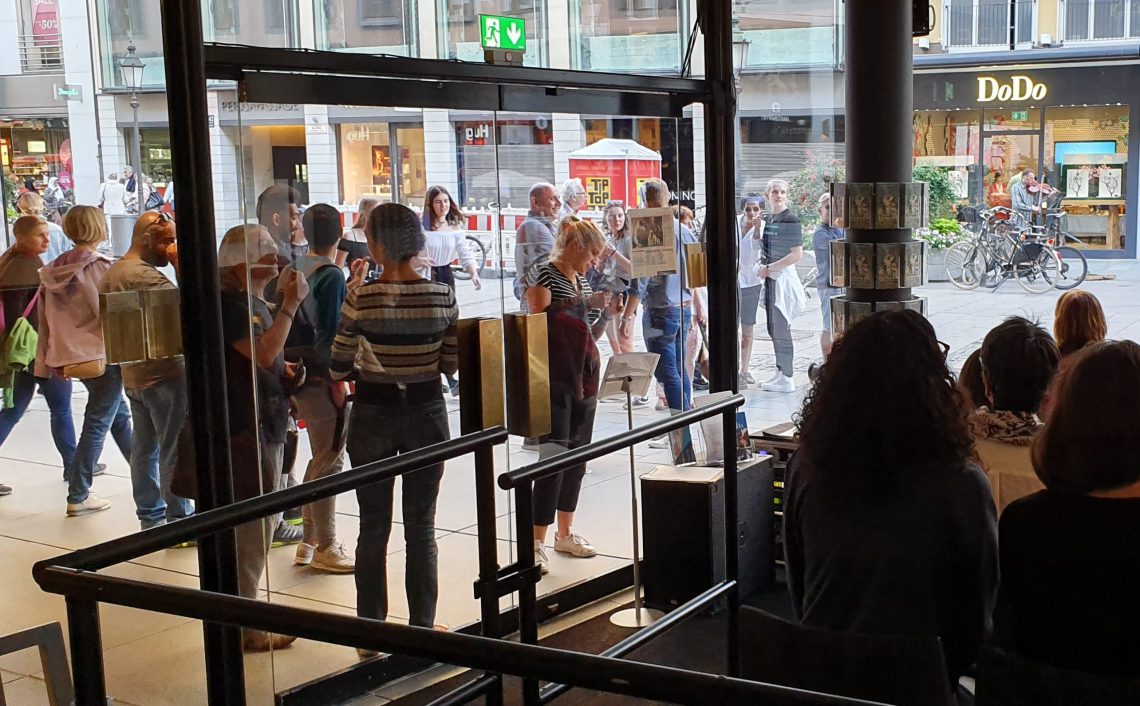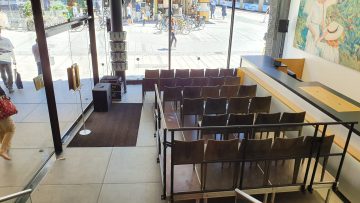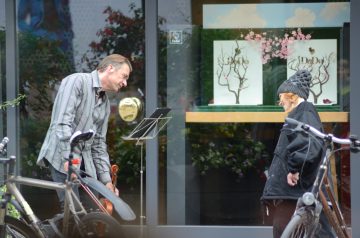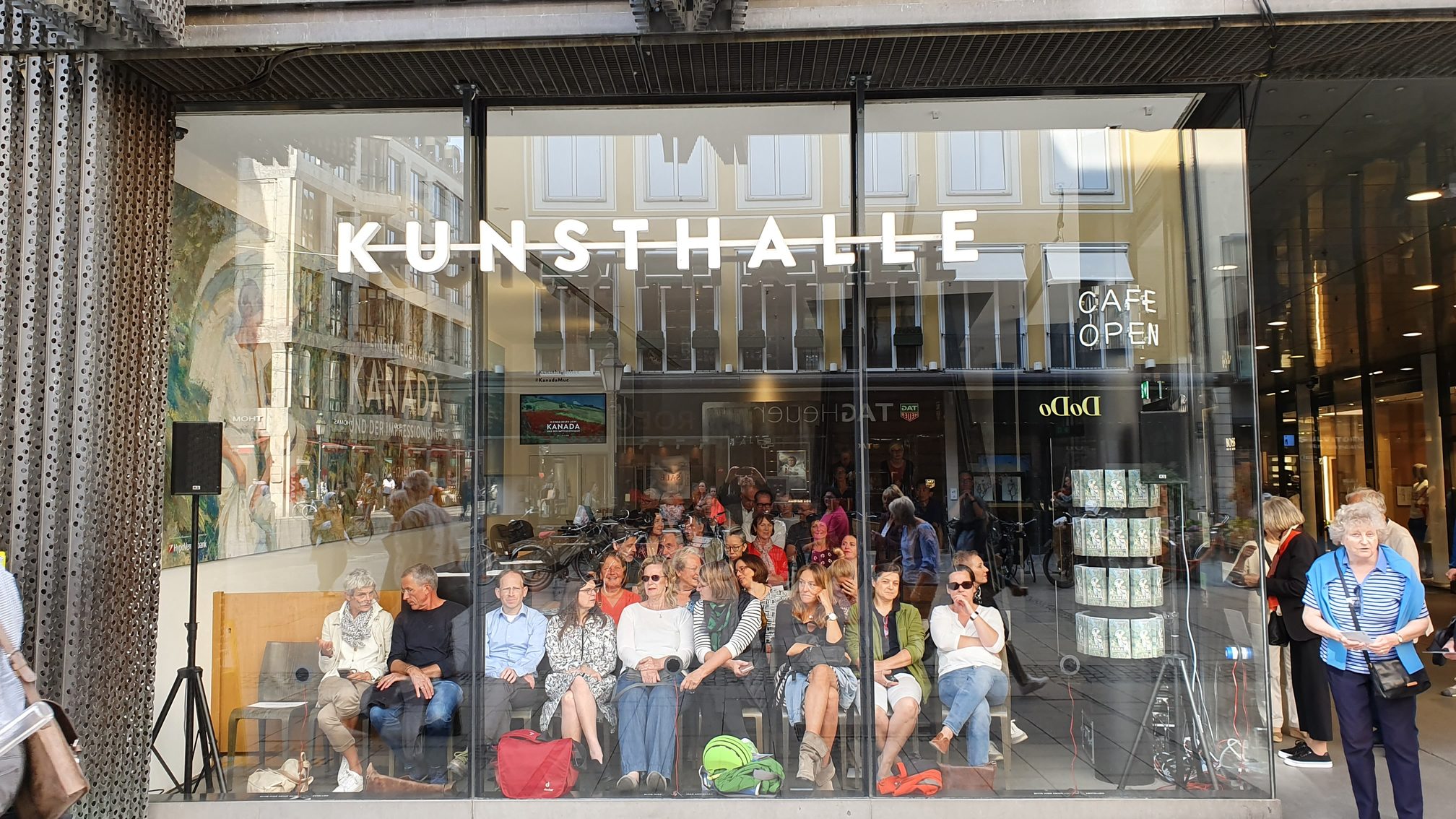Elsa Büsing is a theatre scholar and dramaturge and has taken over the mediation work at the door of “Isolde”. I feel great humility at her serenity and willingness to provide information, with which she has received and answered the stream of questions and communication needs that showered upon her. From this position of interface she writes here, at my invitation, about “Isolde“.

Art of Living
Thoughts on Mathis Nitschke’s ISOLDE, by Elsa Büsing
People rush through the Munich pedestrian zone. Have business appointments, full shopping bags, rush by on e-scooters. A street musician stands in front of a shop, playing J.S. Bach. A homeless person moves between the people, spreads out her few belongings, creates – unnoticed by the passing crowd – her small private space. Everyday life in downtown Munich.
People sit behind a glass wall. Staggered in several rows, they stare out at Munich’s pedestrian zone, watching the hustle and bustle that takes place in front of them. KUNSTHALLE stands in large letters above the glass hall. People rushing by stop – irritated by this unusual sight – waving, frightening, shaking their heads, laughing, quickly moving on.
 Inside and outside, two perspectives – two worlds between art and real life. Inside an audience tribune, one sits protected behind thick glass panes and observes, theatrically framed and sonically designed, scenes in real everyday life. Real and artificially played everyday sounds, real passers-by and artistic characters intertwine. On the outside, the street musician playing the viola and the homeless person (Isolde) are only gradually recognizable as part of the performance. The two artists fit so closely into the street scene that the passers-by hardly notice them. The latter is most suspicious of the unfamiliar sight they see in the Kunsthalle’s entrance hall. People who concentrate on observing the world seem to cause more irritation than a street musician and a homeless person, two people with precarious living conditions, both trying to find their place in the world, claim to create it, or simply survive. With their actions, they are ruthlessly exposed to the eyes of their audience, who in turn are displayed like in a glass cabinet – and at some point on the street this leads to people stopping every now and then and beginning to reflect on the situation.
Inside and outside, two perspectives – two worlds between art and real life. Inside an audience tribune, one sits protected behind thick glass panes and observes, theatrically framed and sonically designed, scenes in real everyday life. Real and artificially played everyday sounds, real passers-by and artistic characters intertwine. On the outside, the street musician playing the viola and the homeless person (Isolde) are only gradually recognizable as part of the performance. The two artists fit so closely into the street scene that the passers-by hardly notice them. The latter is most suspicious of the unfamiliar sight they see in the Kunsthalle’s entrance hall. People who concentrate on observing the world seem to cause more irritation than a street musician and a homeless person, two people with precarious living conditions, both trying to find their place in the world, claim to create it, or simply survive. With their actions, they are ruthlessly exposed to the eyes of their audience, who in turn are displayed like in a glass cabinet – and at some point on the street this leads to people stopping every now and then and beginning to reflect on the situation.
Inside and outside, it’s about our lives, about our attitude to the world. Not only do the street musician and the homeless, two people often overlooked in the hectic pace of everyday life, show us that art gives us dimensions and ways of life beyond the daily struggle for recognition, success and money, it also shows us that all too often we don’t want to see the downside of prosperity, poverty, loneliness, social inequality, especially in Munich, and surround ourselves with bulletproof glass “so as not to break”, as one passer-by remarked. Romantisation and dissection of our reality.
 The artistic play with our everyday reality gains a very special immediacy through the very free form of the piece. Neither in “Volte-Face” for viola solo by Georges Aperghis (a rather unusual piece for a street musician), in the libretto by Thomas Jonigk, nor in Isolde’s character conception can one find any structures that give security and stability. Isolde gives incoherent fragments of sentences of herself, mostly to herself, rarely to others, only for a brief moment the violist and Isolde interact. This free space, however, creates many possibilities for chance encounters, interactions, surprising and unplannable moments between art and life – it is chance and risk at the same time. Each performance is different, each audience – inside and outside – reacts differently.
The artistic play with our everyday reality gains a very special immediacy through the very free form of the piece. Neither in “Volte-Face” for viola solo by Georges Aperghis (a rather unusual piece for a street musician), in the libretto by Thomas Jonigk, nor in Isolde’s character conception can one find any structures that give security and stability. Isolde gives incoherent fragments of sentences of herself, mostly to herself, rarely to others, only for a brief moment the violist and Isolde interact. This free space, however, creates many possibilities for chance encounters, interactions, surprising and unplannable moments between art and life – it is chance and risk at the same time. Each performance is different, each audience – inside and outside – reacts differently.
Martina Koppelstetter and Klaus-Peter Werani have to create new playing spaces for each other in a direct environment that she usually ignores more than pays attention to at first. But slowly the situation is transformed, the artificial penetrates more and more the real. Street musicians and homeless people go from an ordinary casualness to a formal attitude, become more and more clearly artificial figures, sink more and more into their art spaces in the midst of everyday life, language becomes song – until finally the undulating orchestral sounds of Isolde’s Liebestod indoors and outdoors flood the rooms, singing and violas merge, inside and outside in them. And then disappear again.
A moment of art of living.


